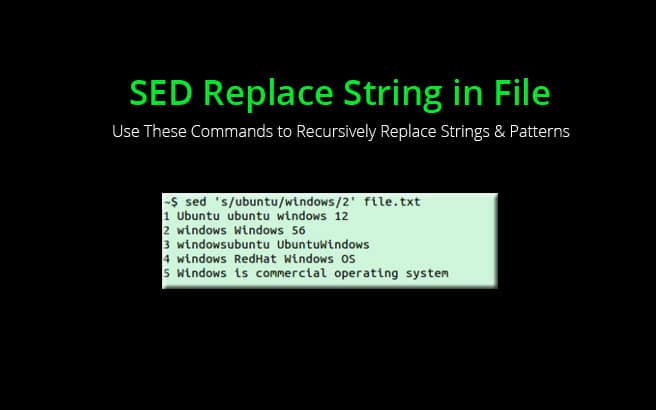
So, what is SED Replace?
SED stands for Stream Editor. This is a powerful text processing tool available in Unix and Unix-like operating systems. The ‘replace’ functionality of sed is one of its most commonly used features. The function allows users to find and replace text patterns in files or input streams. SED replace is an essential tool for system administrators, developers, and anyone who needs to manipulate text efficiently from the command line.
Basic Syntax and Usage
The basic syntax used with sed replace includes
Here, ‘s’ stands for substitute. By default, sed replaces only the first occurrence of the pattern in each line. To replace all occurrences, use the global flag ‘g’:
Meanwhile, to replace “apple” with “orange” in a file named fruits.txt, you can follow this example:
By default, sed prints the modified text to standard output. To save changes to the file, use the -i option:
Common SED Replace Commands
- Replace string in a specific line:
sed '3s/old/new/' file.txt - Replace string in a range of lines:
sed '2,5s/old/new/g' file.txt - Replace multiple patterns:
sed -e 's/old1/new1/g' -e 's/old2/new2/g' file.txt - Case-insensitive replacement:
sed 's/old/new/gI' file.txt - Replace whole words only:
sed 's/\bold\b/new/g' file.txt
Advanced SED Replace Techniques
- Using regular expressions:
sed 's/[0-9]\+/NUMBER/g' file.txt - Backreferences for complex replacements:
sed 's/\(.*\):\(.*\)/\2:\1/' file.txt - Conditional replacement:
sed '/pattern/s/old/new/g' file.txt - Replacing newline characters:
sed ':a;N;$!ba;s/\n/ /g' file.txt - Using sed with pipes:
echo "Hello, World!" | sed 's/World/Universe/'
SED Replace in Scripts
The command is also often used in shell scripts for text processing tasks. Here are some examples:
Batch file renaming

Updating configuration files:
Data Cleaning
Best Practices and Tips
- Use single quotes around sed expressions to prevent shell expansion.
- Always test your sed commands on a copy of the file before applying changes.
- Use the -E option for extended regular expressions:
sed -E 's/regex_pattern/replacement/g' file.txt - When dealing with special characters, escape them with backslashes:
sed 's/\$/USD/g' prices.txt - Use the -n option with ‘p’ flag to print only modified lines:
sed -n 's/pattern/replacement/p' file.txt
What are some of the Alternatives to SED Replace
sed is a powerful tool. However there are other alternatives and tools that can be used instead of sed.
- awk: This is more suitable tool for more complex text processing tasks.
- perl: This tool offers far more advanced regex features than sed.
- tr: This command is useful for simple character replacements.
- grep: The grep command is a great tool for searching, it often used in combination with sed
- Visual editors are usually employed for interactive replacements in small files
Troubleshooting Issues with SED Replace
Common issues with sed replace include:
- Unexpected results with special characters: Use backslashes to escape them.
- Changes not saved: Ensure you’re using the -i option to edit files in-place.
- Patterns not matching: Double-check your regular expressions and consider using -E for extended regex.
- Performance issues with large files: Consider using alternative tools or breaking the task into smaller chunks.
Why is This Important
While mastering the sed command is crucial for anyone working with text files in Unix environments, it’s not just about simple find-and-replace operations; sed’s power lies in its ability to perform complex text transformations efficiently. Whether you’re managing configuration files, cleaning up data, or automating text processing tasks, proficiency with sed replace can significantly boost your productivity.
How Can You Actually Use This?
- In System Administration: You can use the sed command to quickly update configuration files across multiple servers.
- Used in Data Cleaning: You can clean and format large datasets by removing / replacing unwanted characters or standardizing formats.
- You can use this in Code Refactoring: The command can be used to perform bulk changes in the source code, like updating function names or variable conventions.
- Used for Log Analysis: The command can be implemented to extract specific information from log files or reformat logs for easier reading.
- Batch File Processing: You can employ the command to automate text transformations on multiple files in a single command.
Remember, the key to effectively using the sed command is having a clear understanding of its syntax and the power of regular expressions. With practice, you’ll find that the command is increasingly becoming an indispensable tool in your command-line toolkit, enabling you to manipulate text with precision and efficiency.
Related Articles
How to use sed to find and replace text in files in Linux
How to Use Sed to Find and Replace a String in a File
More Articles from Unixmen




